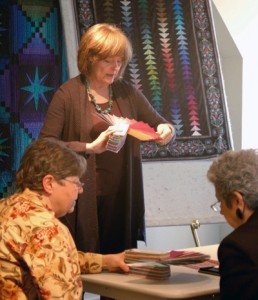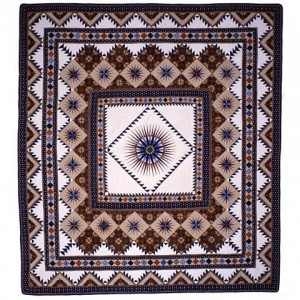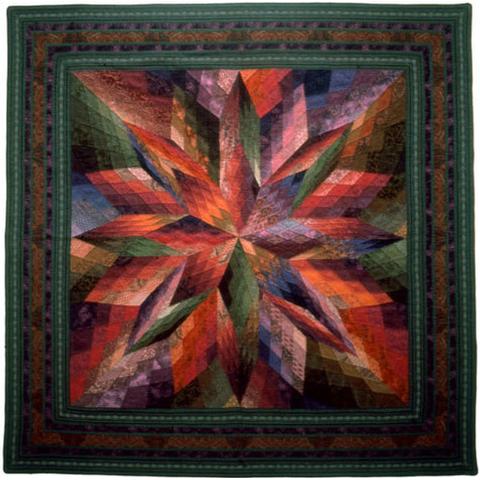Why Quilts Matter – Question & Answer with Jinny Beyer

Jinny Beyer
Few people in the quilting universe have had as much influence or as long a list of accomplishments as Jinny Beyer. Jinny was the first to design a line of fabric expressly for quilters, most notably the Jinny Beyer Palette, which features 150 tonal and multi-screen tonal designs set in a complete spectrum of color.
She remembers:
“When I was first asked to design fabric, I was given a chart of several colors and told to design a few basic fabrics using only these colors. I told them “no”. The colors they gave me were the “in” colors of the time and I knew that when the fabric was produced the colors would already be on their way out. My fabric designs do not have high contrast as I love to use many layers of colors and I print with different screens to create a dimensional or textured look in each of them. I used my collection of antique quilts as sources of inspiration for my fabric designs. Yet today I am inspired by so many other things around me – old documents, wallpaper, buildings, moldings, doors, floors, and, of course, nature.”
Jinny’s legendary quilting expertise (she hands pieces and hand quilts) first achieved national prominence in 1978 when her Ray of Light medallion quilt beat out 10,000 entries and captured the top prize in the Great American Quilt Contest. In 1999, Ray of Light was chosen as one of the 100 Best American Quilts of the 20th Century, and in 1984 Jinny was inducted into The Quilters Hall of Fame. She has authored numerous books while teaching and traveling extensively, and continues to design fabric collections for RJR Fabrics, most recently Malam Batiks.
We managed to corral Jinny long enough to ask her a few questions from the Why Quilts Matter Discussion Guide. Given her lengthy history as a quilting professional, we were curious to know how she got started long before quilts moved in to the forefront as they have in recent years.
When and why did you start to make quilts?

Jinny Beyer – Ray of Light, 1977
I started making quilts in 1970 while I was living in India. I was a knitter and ran out of yarn. I needed a project to keep my hands busy. I had seen a Grandmother’s Flower Garden quilt and although I thought it looked a little like a mattress pad – I wanted to make a quilt. I didn’t want a white background as I had seen in the other quilt and I loved the block printed Indian fabrics with their dark, rich colors. I went down to the local market, buying what they had available, most of which was made locally, and gathered some scraps that I had on hand to make the quilt. In making that quilt, I found that I loved it and still do. All of my early quilts were made mostly of those beautifully colored Indian fabrics so I truly had an interest in fabric from the very beginning.
Are you making quilts for the same reasons now as you did when you started?
I rarely have the time to make anything for myself. I am constantly designing for my customers and exploring different designs for my quilts and fabrics. Even though I don’t have the time to make something for myself, I find that I don’t miss it because I enjoy this creative process.

Jinny Beyer – Rhapsody, 1997

Jinny Beyer – Triple Play, 2003
Traditional quilt patterns deal with formal art issues in composition: rhythm, movement, repetition, color theory, etc. Why do we rarely hear quilts talked about with that kind of vocabulary?
Historically, quilting has been considered a craft. Jonathan Holstein and his wife Gail van der Hoof had acquired a large collection of quilts. In 1971, 62 of their quilts were placed on display at the Whitney Museum of American Art in New York City. This was probably the first time that we started to look at quilts as art. There has always been a discussion in the quilt world about contemporary vs. traditional, with many feeling that a quilt must be different from the traditional to be considered art. However, the elements of art – the geometric repetition, the movement, and the color theory – have all been around as a part of traditional quilts too. It should not be overlooked that many of the elements found in contemporary quilts are also found in traditional quilts. I have a quote that I love from St. Francis of Assisi:
“He who works with his hands is a laborer.
He who works with his hands and his head is a craftsman.
He who works with his hands and his head and his heart is an artist.”

Jinny Beyer – Sundance, 1992
What factors do you take into consideration when deciding to purchase a quilt?
When I purchase quilts, I buy antique quilts. I have purchased antique quilts over the years and I wish I could buy every one of them that I see! I now limit myself to mostly charm quilts as every fabric is different – it is like having a card catalogue of fabrics of the time. These quilts and fabrics will often inspire my own designs. Long-time customers of mine will recognize that “black eyelash” has been in every one of my palette collections through the years. The design for black eyelash came from one of the fabrics in an antique quilt.
What is next for you?
After over thirty years of designing fabrics, I have recently come out with my first line of batiks. I found the process of designing these fabrics very different from what I am used to doing. I was able to travel to Indonesia and watch my fabric being manufactured from beginning to end. I am already working on my next line of batiks while designing other fabric collections.
More about Jinny Beyer
Jinny, her husband, and several dogs and cats live just outside Washington, D.C. in Great Falls, Virginia. To learn more about Jinny’s design process and her life in quilting, watch her interview with the Alliance for American Quilts. Jinny Beyer has an extensive website, rich in images, resources, kits, a noteworthy and inspiring quilt gallery, and loads of free tips, patterns and lessons. See them all at JinnyBeyer.com.
Photos courtesy Jinny Beyer.



Jinny’s fabrics inspired my mom to start quilting and it wasn’t long before I got pulled in, too! She has always been an inspiration to me and she continues to design fabric and quilts that I just LOVE!
Dear Jinny, I was quilting since I was 16 .In 1974 I bought your book with the picture of the first quilt you made in 1970.It inspired me to be creative.I have made many quilts since mostly as presents to members of my family.zi still get excited when zi look at your creations and colors. I wanted to thank you for being such a great teacher.